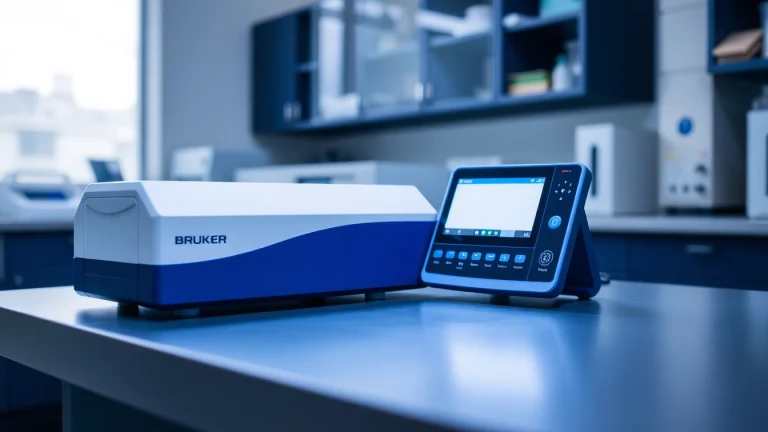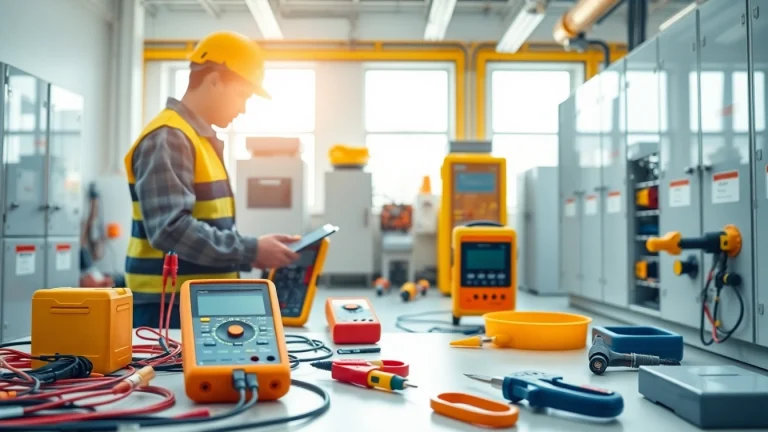
Maximizing Efficiency with the Bruker EOS 500 Handheld LIBS Analyzer for Material Analysis
Understanding the Bruker EOS 500 Handheld LIBS Analyzer
What is the Bruker EOS 500?
The Bruker EOS 500 Handheld LIBS Analyzer is an advanced analytical instrument that employs laser-induced breakdown spectroscopy (LIBS) technology for real-time elemental analysis of various materials. This portable device enables users to gather precise data on the elemental composition of a sample within seconds, making it particularly valuable for industries where understanding material composition is crucial.
The EOS 500 is designed for ease of use in various environments, allowing for in-field applications ranging from metal alloy checks to detecting contaminants in soil and waste. With its robust construction, it can withstand harsh conditions while providing reliable and accurate readings, reducing the reliance on conventional laboratory testing methods.
Key Features and Specifications
The Bruker EOS 500 boasts a range of innovative features that enhance its functionality and user experience:
- High Sensitivity and Accuracy: The device utilizes advanced LIBS technology, ensuring the detection of trace elements (down to parts per million) with high precision.
- User-Friendly Interface: Featuring an intuitive touchscreen display, the EOS 500 allows users to navigate menus and access data easily.
- Battery Operated: The handheld design is powered by Lithium-ion batteries, providing substantial operational time and eliminating the need for constant power sources.
- Real-Time Analysis: Users can receive instant feedback on elemental composition, facilitating quick decision-making.
- Robust Design: The analyzer is built to withstand the rigors of industrial environments, offering protection against water, dust, and drops.
- Lightweight and Portable: Weighing only a few kilograms, the EOS 500 is highly portable and can be easily transported to various sites.
Applications in Various Industries
The versatility of the Bruker EOS 500 lends itself to numerous applications across various sectors:
- Metal Industries: Used for verifying alloy composition and ensuring compliance to industry standards.
- Environmental Monitoring: Detects heavy metals and contaminants in soil and water, supporting environmental assessment and remediation efforts.
- Mining: Assists in the rapid analysis of ore samples to determine the presence and concentration of valuable minerals.
- Recycling: Facilitates the sorting of recyclable materials by quickly identifying their elemental makeup, improving the efficiency of recycling processes.
- Education and Research: Serves as an educational tool in academic settings to teach students about materials science and analytical chemistry.
Benefits of Using the Bruker EOS 500 Handheld LIBS Analyzer
Speed and Efficiency in Material Testing
One of the most significant advantages of the Bruker EOS 500 is its ability to perform rapid material testing. Traditional laboratory techniques often require extensive sample preparation and extensive wait times for results. In contrast, the EOS 500 enables simultaneous analysis of multiple elements within seconds. This immediate feedback is essential in production environments, where timely decisions can lead to cost savings and efficiency improvements.
For example, a manufacturing plant can utilize the EOS 500 to quickly assess the composition of incoming raw materials, ensuring quality controls are met without delaying the production line. This not only streamlines operations but also enhances product reliability.
Portability and User-Friendly Design
The portable design of the Bruker EOS 500 is another critical benefit. Unlike bulky laboratory analyzers that require a fixed location, the handheld nature allows for on-site evaluations. Users can move swiftly between sampling locations, making it practical for fieldwork in mining, recycling, or environmental assessments.
The user-friendly interface of the EOS 500 is designed with simplicity in mind, allowing personnel with minimal training to operate it effectively. This ease of use reduces the learning curve and enables more team members to engage in material analysis operations.
Cost-Effectiveness Compared to Traditional Methods
Implementing the Bruker EOS 500 can result in substantial cost savings for organizations. The initial investment in a handheld LIBS analyzer is often offset by the reduction in labor costs associated with traditional testing methods, which require numerous staff hours for manual analysis and data processing. Moreover, the ability to conduct tests in real-time decreases the necessity for extensive inventory and reduces wastage.
Over time, the cost advantages become even more prominent, as organizations can mitigate compliance risks, enhance operational efficiency, and reduce downtime related to material testing. These elements cumulatively contribute to improved profitability.
How to Operate the Bruker EOS 500 Handheld LIBS Analyzer
Step-by-Step Operating Guidelines
Operating the Bruker EOS 500 is straightforward, allowing users to get started quickly. Here are the essential steps for effective operation:
- Calibration: Before conducting tests, ensure the device is calibrated according to the manufacturer’s specifications. Follow the guidelines provided to calibrate based on the types of materials you will be analyzing.
- Power On: Turn on the device and let it boot up, allowing time for the internal systems to initialize.
- Select the Material Type: Use the touchscreen to choose the type of material you will analyze, ensuring the correct parameter settings for accurate results.
- Prepare the Sample: Ensure that the sample is clean and appropriately presented for analysis (e.g., flat and free from coatings).
- Conduct the Analysis: Position the device correctly, then fire the laser, following the on-screen instructions for best practices.
- Record and Analyze the Results: Once the test is complete, review the real-time data displayed on the screen and make necessary notes for future reference.
- Power Down: Turn off the device after use to preserve battery life and ensure proper maintenance.
Best Practices for Accurate Measurements
To ensure accuracy in measurements using the Bruker EOS 500, consider these best practices:
- Sample Preparation: Thorough and appropriate preparation of the samples can significantly affect the accuracy of readings.
- Stable Environment: Conduct tests in a stable environment to reduce interference from electromagnetic noise or environmental variables.
- Regular Calibration: Implement a routine calibration schedule to maintain accuracy over time.
- Consistency in Technique: Use the same technique and settings for similar types of materials to ensure comparability of results.
- Documentation: Keep detailed records of all analyses for both compliance and internal review, aiding in quality control.
Common Mistakes to Avoid
Users new to the Bruker EOS 500 may encounter several common pitfalls. Here are some critical mistakes to avoid:
- Inadequate Sample Cleaning: Failing to clean samples thoroughly can lead to contamination and skewed results.
- Operating in Non-Ideal Conditions: Using the device in poor lighting or at unstable temperatures can affect readings.
- Ignoring Calibration: Skipping calibration can result in inaccurate readings, leading to faulty conclusions.
- Neglecting User Manual: Not referring to the user manual for specific instructions can lead to misuse.
Comparing the Bruker EOS 500 with Other Analyzers
Key Competitors in the Handheld LIBS Market
The handheld LIBS analyzer market features several competitors to the Bruker EOS 500. Some notable contenders include:
- Olympus Innov-X Delta: Another highly regarded handheld analyzer known for its performance in metal analysis.
- Thermo Scientific Niton XRF Series: Although primarily an XRF device, the Niton series offers versatility in material testing.
- Horiba Scientific: They provide reliable analytical solutions but often focus on laboratory-grade technology, which may lack portability.
Performance Metrics: A Comparative Study
When comparing the performance of the Bruker EOS 500 with its key competitors, specific metrics stand out:
| Feature | Bruker EOS 500 | Olympus Innov-X Delta | Thermo Scientific Niton |
|---|---|---|---|
| Weight | 1.3 kg | 1.5 kg | 1.8 kg |
| Analysis Speed | 1-10 seconds | 30 seconds | 10-30 seconds |
| Battery Life | 10 hours | 8 hours | 6 hours |
| Maximum Detection Limit | 0.1% (ppm) | 0.5% (ppm) | 1% (ppm) |
Pros and Cons of Each Option
While each analyzer presents opportunities, it is essential to weigh the pros and cons:
Bruker EOS 500
- Pros: Fast analysis, lightweight, durable, user-friendly.
- Cons: Higher initial investment costs compared to entry-level devices.
Olympus Innov-X Delta
- Pros: Established brand with a reputation for reliability.
- Cons: Slower analysis times and slightly heavier design.
Thermo Scientific Niton
- Pros: Versatile with dual technology for XRF and LIBS.
- Cons: Generally heavier and less user-friendly than the EOS 500.
Future Trends in Handheld LIBS Technology
Innovations and Advancements on the Horizon
The field of handheld LIBS technology is continuously evolving, with several innovations on the horizon that promise to enhance the functionality and efficiency of devices like the Bruker EOS 500. Future trends may include:
- Integration with AI: The incorporation of artificial intelligence in data analysis to improve the accuracy and predictive capabilities of material assessments.
- Enhanced Connectivity: Improved wireless connectivity for real-time data sharing with cloud-based management systems.
- Sustainability Initiatives: Development of eco-friendly components and materials to align with global sustainability goals.
Impact of Emerging Technologies on Material Analysis
Emerging technologies such as machine learning and big data analytics are expected to have a profound impact on the future of material analysis. These technologies will allow for the processing of vast amounts of data collected from handheld devices, leading to better insights into material properties and behavior over time.
Preparing for Changes in Industry Standards
As technological advancements occur, industries must remain vigilant in monitoring changes in regulations and standards that may arise from these innovations. Firms using the Bruker EOS 500 and similar technologies should engage in continuous training, review compliance requirements, and adapt to changes proactively to ensure they maintain industry competitiveness.


